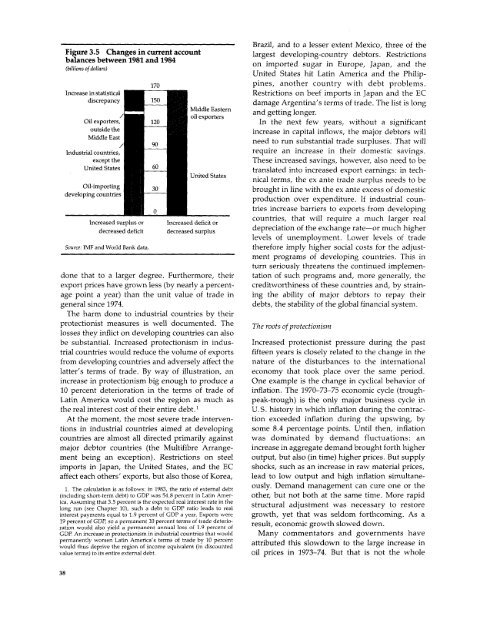World Bank Document
World Bank Document
World Bank Document
You also want an ePaper? Increase the reach of your titles
YUMPU automatically turns print PDFs into web optimized ePapers that Google loves.
Brazil, and to a lesser extent Mexico, three of the<br />
Figure 3.5 Changes in current account largest developing-country debtors. Restrictions<br />
balances between 1981 and 1984g<br />
g<br />
(bilaions ofbdollars)<br />
on imported sugar in Europe, Japan, and the<br />
United States hit Latin America and the Philip-<br />
170 pines, another country with debt problems.<br />
Increase in statistical<br />
Restrictions on beef imports in Japan and the EC<br />
discrepancy 150 damage Argentina's terms of trade. The list is long<br />
Middle Eastern and getting longer.<br />
/ oil exporterssinfct<br />
Oil exporters, 120 In the next few years, without a significant<br />
outside the<br />
increase in capital inflows, the major debtors will<br />
Middle East<br />
/ 90 need to run substantial trade surpluses. That will<br />
Industrial countries, - require an increase in their domestic savings.<br />
except the<br />
United States 60<br />
These increased savings, however, also need to be<br />
translated into increased export earnings: in tech-<br />
developing<br />
United States<br />
UnitedpStates<br />
nical terms, the ex ante trade surplus needs to be<br />
Oil-importing 30 brought in line with the ex ante excess of domestic<br />
countries<br />
production over expenditure. If industrial coun-<br />
tries increase barriers to exports from developing<br />
o<br />
Increased surplus or Increased deficit or countries, that will require a much larger real<br />
decreased deficit decreased surplus depreciation of the exchange rate-or much higher<br />
levels of unemployment. Lower levels of trade<br />
Source: IMF and <strong>World</strong> <strong>Bank</strong> data.<br />
therefore imply higher social costs for the adjust-<br />
- nment programs of developing countries. This in<br />
turn seriously threatens the continued implemendone<br />
that to a larger degree. Furthermore, their tation of such programs and, more generally, the<br />
export prices have grown less (by nearly a percent- creditworthiness of these countries and, by strainage<br />
point a year) than the unit value of trade in ing the ability of major debtors to repay their<br />
general since 1974.<br />
debts, the stability of the global financial system.<br />
The harm done to industrial countries by their<br />
protectionist measures is well documented. The The roots of protectionism<br />
losses they inflict on developing countries can also<br />
be substantial. Increased protectionism in indus- Increased protectionist pressure during the past<br />
trial countries would reduce the volume of exports fifteen years is closely related to the change in the<br />
from developing countries and adversely affect the nature of the disturbances to the international<br />
latter's terms of trade. By way of illustration, an economy that took place over the same period.<br />
increase in protectionism big enough to produce a One example is the change in cyclical behavior of<br />
10 percent deterioration in the terms of trade of inflation. The 1970-73-75 economic cycle (trough-<br />
Latin America would cost the region as much as peak-trough) is the only major business cycle in<br />
the real interest cost of their entire debt.,<br />
U.S. history in which inflation during the contrac-<br />
At the moment, the most severe trade interven- tion exceeded inflation during the upswing, by<br />
tions in industrial countries aimed at developing some 8.4 percentage points. Until then, inflation<br />
countries are almost all directed primarily against was dominated by demand fluctuations: an<br />
major debtor countries (the Multifibre Arrange- increase in aggregate demand brought forth higher<br />
ment being an exception). Restrictions on steel output, but also (in time) higher prices. But supply<br />
imports in Japan, the United States, and the EC shocks, such as an increase in raw material prices,<br />
affect each others' exports, but also those of Korea, lead to low output and high inflation simultane-<br />
1. The calculation is as follows: in 1983, the ratio of external debt ously. Demand management can cure one or the<br />
(including short-term debt) to GDP was 54.8 percent in Latin Amer- other, but not both at the same time. More rapid<br />
ica. Assuming that 3.5 percent is the expected real interest rate in the structural was necessary restore<br />
long run (see Chapter 10), such a debt to GDP ratio leads to real adjustment to<br />
interest payments equal to 1.9 percent of GDP a year. Exports were growth, yet that was seldom forthcoming. As a<br />
19 percent of GDP, so a permanent 10 percent terms of trade deterio- result, economic growth slowed down.<br />
ration would also yield a permanent<br />
annual loss of 1.9 percent of<br />
GDP. An increase in protectionism in industrial countries that would Many commentators and governments have<br />
permanently worsen Latin America's terms of trade by 10 percent attributed this slowdown to the large increase in<br />
would thus deprive the region of income equivalent (in discounted<br />
value terms) to its entire external debt.<br />
oil prices in 1973-74. But that is not the whole<br />
38

















